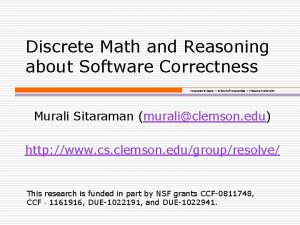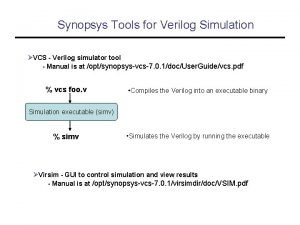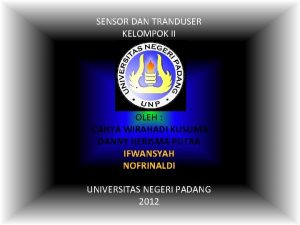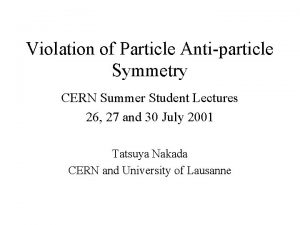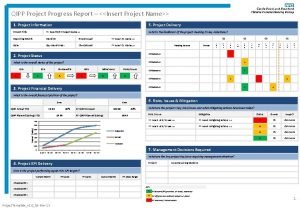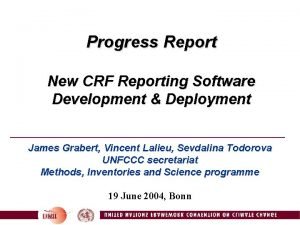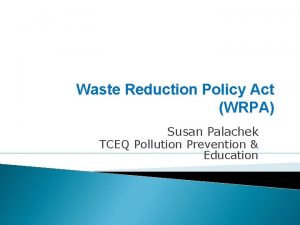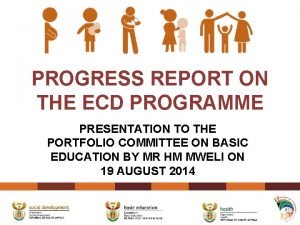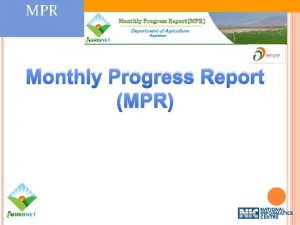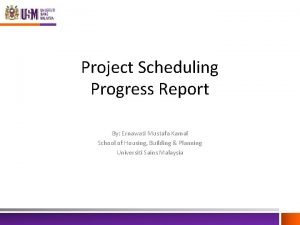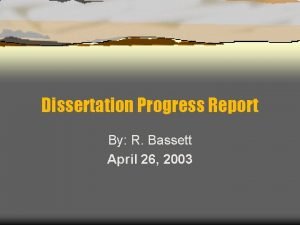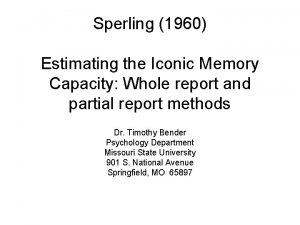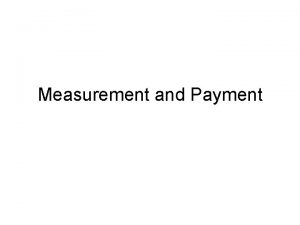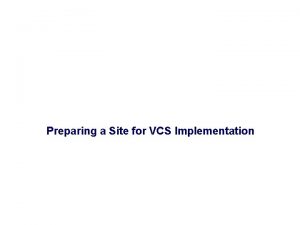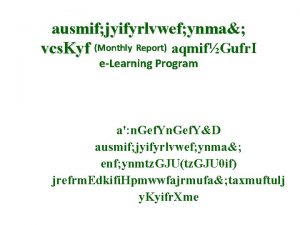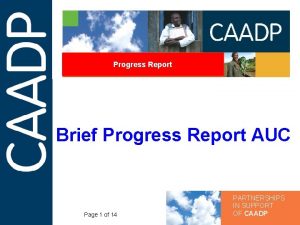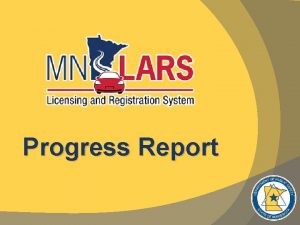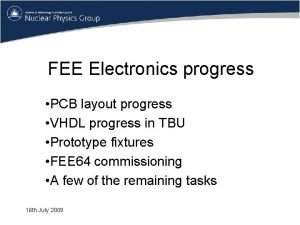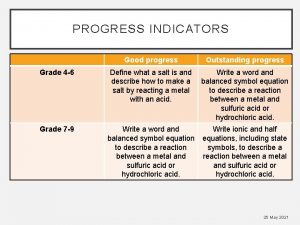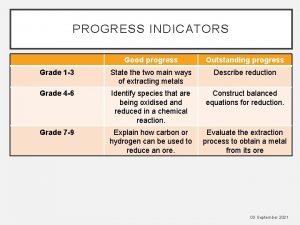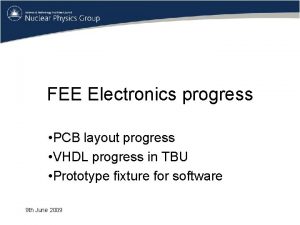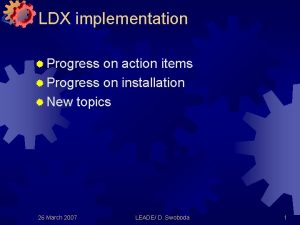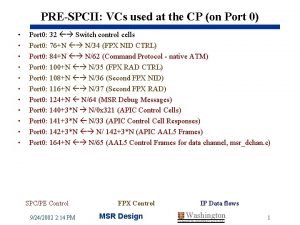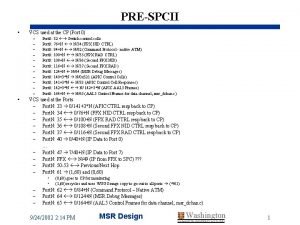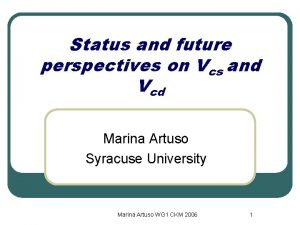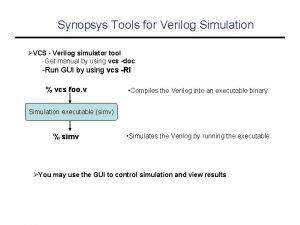8 33 k Hz VCS Implementation progress report




























- Slides: 28

8. 33 k. Hz VCS Implementation progress report EUR/NAT MID Preparatory Workshop Jacky Pouzet HOU - CFC Network Manager

Summary § Regulatory framework § Implementation status and planning § Analysis supporting the Network Impact Assessment § 8. 33 k. Hz VCS NM implementation support 8. 33 VCS Implementation Support 2

(EU) IR 1079/2012 - VCS Regulation 8. 33 VCS Implementation Support 3

Area concerned IR 8. 33 VCS Implementation Support 4

Who is affected? § General Air Traffic (GAT) § § § All categories of aircraft operating below FL 195 within ICAO EUR region where EU MS are responsible for providing ATS Exemptions possible under certain circumstances ANSPs § State aircraft § Transport/non-transport state aircraft operating below FL 195 (Military, police, customs, civilian aircraft operating as military, police, etc. ) § § 8. 33 VCS Implementation Support Ground vehicles Aerodromes IR 5

Equipment § All radios on EU market (VHF band) past 2013 are 8. 33 VCS capable § All equipment put into service after 2013 is 8. 33 VCS capable § All new airworthiness certificate past 2013 requires 8. 33 VCS equipment IR 8. 33 VCS Implementation Support 6

§ Regulatory framework § Implementation status and planning § Analysis supporting the Network Impact Assessment § 8. 33 k. Hz VCS NM implementation support 8. 33 VCS Implementation Support 7

8. 33 VCS Implementation Status § Based on SAFIRE information April 2017 for Switzerland, Norway and EU MS § § Only operational and assigned frequency assignments Excluding frequencies excepted from conversion by VCS Regulation (CLIMAX, ACARS, VDL, EMG, SAR) Service A/A A/G ACC AFIS APP AS ATIS FIS GUARD OPC PAR TWR VOLMET Grand Total 25 k. Hz 16 1560 696 774 1020 625 380 117 8. 33 k. Hz 6 290 506 24 54 130 20 1092 128 968 49 1 774 2 59 6 Total Assignments 22 1850 1202 798 1074 755 400 117 1 1866 130 1027 55 7425 1873 9298 8. 33 VCS Implementation Support 8

8. 33 VCS Implementation planning Exemptions due to State Total Convertible due to safety due to local 25 k. Hz to Offset carrier Exemptions 25 k. Hz aircraft (CLIMAX) requirements measures accommodation No. 7425 Assignments 505 830 233 421 1989 5436 Note: these figures are in continuous evolution while states are finalising their strategy for conversion 8. 33 VCS Implementation Support 9

8. 33 VCS Implementation planning No Assignments planned for conversion during 2016 during 2017 during 2018 no plan or beyond 2018 11 222 3178 2025 8. 33 VCS Implementation Support 10

Summary § Regulatory framework § Implementation status and planning § Analysis supporting the Network Impact Assessment § 8. 33 k. Hz VCS NM implementation support 8. 33 VCS Implementation Support 11

Assessment Objective § Evaluate the impact of local measures granting exemptions on the VHF spectrum availability § As an individual (isolated) effect (State level) § Global effect (EU level) § Analyse the availability of frequency assignments in the future considering: § The forecasted frequency demand for all States § Other known constraints (e. g. frequency demand in “non 8. 33 States”) The Network Impact is defined by the probability of success in the process of allocating new frequency assignments, taking into account the forecasted demand. A limited Network Impact can be considered in the case in which the future frequency demand can be satisfied without significant delays. 8. 33 VCS Implementation Support 12

Data availability and assumptions § Assessment is performed based on frequency assignment allocation data: $e<Ref> § Available in SAFIRE § § $d(DDMMYY) VHF frequency Service Designated Operational Coverage (DOC) 8. 33 planning (i. e. conversion or exemption) $es $ec $em § For all states § EU Member States (28+2) § Non-EU Member States participating in SAFIRE § Current frequency congestion & forecasted frequency demand § For 25 k. Hz assignments § For 8. 33 k. Hz assignments § In 3 separate areas (Area 1, 2 and 3) based on current spectrum congestion 8. 33 VCS Implementation Support 13

Frequency demand forecast data § The forecast of future demand is based on § § § Analysis of past frequency demand evolution, Known planned developments of the ATM infrastructure as covered by the Network Operations Plan Validation and extrapolation of demand trends based on the current situation Agreed by the States Specific distribution of the demand was considered depending on the geographical position § § § Different trend Different demand Different ratio between 25 k. Hz and 8. 33 k. Hz assignments demand* *Normally a 80%-20% ratio between 8. 33 k. Hz/25 k. Hz assignments demand is considered for all services in Area 1&2, while a 20%-80% ratio is considered for Area 3. This is due to States in Area 3 not being covered by the VCS Regulation 8. 33 VCS Implementation Support 14

Methodology(ies) § Based on frequency demand satisfaction over a period of years (up to 2036) § Measured by assessing the rate of success in finding frequency assignments for the forecasted demand § rate of success above 95% ct a p l im § rate of success below 95% a b o Gl § Dependent on the number of “shifts” allowed § Based on the number of frequencies available in a geographical location § Analysing the contribution of a proposed exemption to the reduction of the number of frequency assignments available in a certain area § Qualifying the impact based on the number of frequencies available at the geographical location where the loss takes place (i. e. a loss of 10 potential new assignments in a location where 100 frequencies are available has not the same impact as having a similar loss in a location where only 11 are available) § for 2018 (conservative case: minimum conversions vs. maximum no of exemptions) l a u d vi Indi act imp 8. 33 VCS Implementation Support 15

Frequency demand satisfaction § Nominal potential implementation scenario § § § The forecasted frequency demand is satisfactory fulfilled (above 95% satisfaction rate) for Area 1 and 2 States A maximum of 2 frequency shifts are allowed in order to allocate a solution Until 2028 for Area 3 all the demand is satisfied above 95% 8. 33 VCS Implementation Support 16

Frequency Congestion - estimated for end of 2018 8. 33 VCS Implementation Support No. of available 8. 33 k. Hz channels based on an ACC 50 NM radius/FL 450 service 17

Example of exemption spectrum contribution for end 2018 8. 33 VCS Implementation Support No. of 8. 33 k. Hz assignments contributing to the spectrum reduction, based on an ACC 50 NM 18 radius/FL 450 service

Frequency demand variations § Double frequency demand (2 shift) § § § The satisfaction rate trend for the States in Area 1 is constantly below 95% The satisfaction rate for the States in Area 2, shows a tendency to decrease through the end of the considered time interval The satisfaction rate for the Area 3 is constantly below 95% and on a decreasing trend 8. 33 VCS Implementation Support 19

Frequency demand variations § Nominal Frequency demand (0 shift) § § § The satisfaction rate trend for the States in Area 1 is constantly below 95% The satisfaction rate for the States in Area 2, while above 95% for the first 9 years of the assessment, decreases and remains below this threshold after 2027 The satisfaction rate for the Area 3 States is constantly below 95% and on a decreasing trend 8. 33 VCS Implementation Support 20

Frequency congestion evolution forecast § Comparison of the 8. 33 k. Hz channel congestion in Europe § Nominal potential implementation scenario in 2018 vs. § 2025 with the forecasted demand added Note: the reduction of the frequency congestion in core Europe is due to most of the local measures granting exemptions being lifted. The increase in congestion in the East European States is due to - the lack of complete planning information from Bulgaria, Greece, Cyprus, - numerous exemptions for State aircraft accommodation (e. g. Romania) - the demand in 25 k. Hz assignments from the States not participating in 8. 33 programme (e. g. Turkey) 8. 33 VCS Implementation Support 21

Frequency Congestion – estimated end 2018 8. 33 VCS Implementation Support No. of available 8. 33 k. Hz channels based on an ACC 50 NM radius/FL 450 service 22

Frequency Congestion – estimated 2025 8. 33 VCS Implementation Support No. of available 8. 33 k. Hz channels based on an ACC 50 NM radius/FL 450 service 23

Summary § Regulatory framework § Implementation status and planning § Analysis supporting the Network Impact Assessment § 8. 33 k. Hz VCS NM implementation support 8. 33 VCS Implementation Support 24

NM Implementation Support Project § Monitoring & Steering implementation § Data collection for conversion planning, exemption, equipment inventory and implementation status § SAFIRE § Direct reporting § VHF Radio Testing Campaign § GA aircraft and equipment repository (833 radio. com) § Coordination of exemptions/derogations § Network Impact Assessment analysis of exemptions § Exemption strategy analysis § Awareness and support to implementation § www. eurocontrol. int/833 § Information dissemination preparation § 833 radio. com § Aero Friedrichshafen briefing (industry, pilots, fight schools, etc. ) 8. 33 VCS Implementation Support 25

Implementation progress below FL 195 EU ATC sectors https: //ext. eurocontrol. int/833/ Airspace_8. 33 k. Hz_Radio. html 8. 33 VCS Implementation Support 26

Questions? 8. 33 VCS Implementation Support 27

8. 33 k. Hz VCS Implementation EUR/NAT MID Preparatory Workshop Thank you! 8. 33 VCS Implementation Support www. eurocontrol. int/833 8. 33@eurocontrol. int
 Difference between status report and progress report
Difference between status report and progress report Physical progress and financial progress
Physical progress and financial progress Vcs observation
Vcs observation Vcs
Vcs Synopsys vcs tutorial
Synopsys vcs tutorial Dinda cahya vcs
Dinda cahya vcs Atm 18
Atm 18 Namndos
Namndos Measure h
Measure h Growing success chart
Growing success chart How to report project progress
How to report project progress Software development progress report
Software development progress report Memo to supervisor
Memo to supervisor Tceq p2 annual progress report
Tceq p2 annual progress report Ecd progress report
Ecd progress report Example of progress report in technical writing
Example of progress report in technical writing Status in progress
Status in progress Seo progress report
Seo progress report Fyp progress report
Fyp progress report Progress report for internship
Progress report for internship Progress report example
Progress report example Yale dissertation progress report
Yale dissertation progress report Partial report technique vs whole report
Partial report technique vs whole report Progress babbage programmable computer
Progress babbage programmable computer The drunkard's progress
The drunkard's progress Tracking student progress charts
Tracking student progress charts Reading for pleasure and progress
Reading for pleasure and progress Progress payments construction
Progress payments construction Kolkata east-west metro work progress
Kolkata east-west metro work progress



